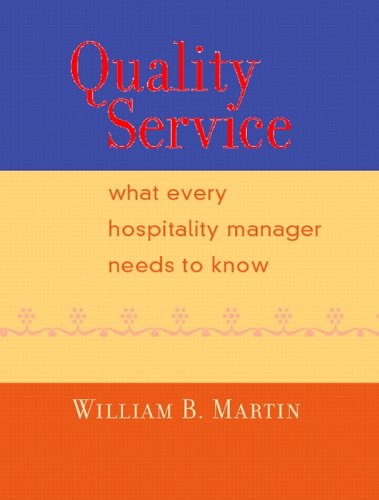
A must-read for all hospitality managers in every sector of the industry, this text serves as a step-by-step guide to providing quality customer service. This book provides 32 Application Interaction Exercises that takes the reader through every aspect of customer service—from assessing customer expectations, to creating a quality service environment, to maintaining quality service. The entire spectrum of the hospitality industry is discussed, including restaurants, hotels, clubs, theme parks, travel, and tourism. For hospitality managers, restaurant managers, club managers, theme park managers, and travel and tourism managers that want a step-by-step guide to providing quality customer service.


must have resource,
This book is excellent.
It’s not wordy. It gets to the point and is structured so it’s a useful tool in setting up the service systems you need.
We have been open 4 years and based on this I recommend this book.
We’re in Taiwan so the book gives info that is applicable to wherever you are.
[…]
Here’s our site so you know this a real review
cheers
Ants
0
Was this review helpful to you?

|Applying service theory to hospitality operations,
Both independent and chain operations can make practical use of Martin’s 32 sets of exercises. If I were in operations, I would casually use some exercises at staff call. I would modify the question or statement as needed to suit my operation. In my current educational environment, I can make just as good use of one example, which is to make the statement: “May I bring you anything else?”
Where is the beauty of using such a simple question? The key is found with the intonation or emphasis applied to the words “I”, “you”, “anything”, or “else”.
I teach in an ESL-student environment, with as many as 12-15 countries represented by as many as 25 students. The course I have been teaching for 6 years is the upper-level 3-credit course in Hotel & Resort Management. Speech and “talk” becomes particulary sensitive when I use a different intonation or emphasis in my discussion delivery, when entertaining a guest speaker, or engaging in lively discussions with students. I have to make sure the words are understood, and then I have to ensure that the intonation I am using is delivery the desired message.
When was the last time you “listened” to how your employees interact with guests?
If you didn’t “get it”, then all the more reason for you to beg, borrow, or buy this book if you find it!
Mario Arnaldo, Ph. D.
Instructor, Travel Industry Management
Hawaii Pacific University
0
Was this review helpful to you?

|